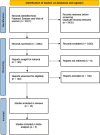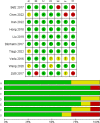Does paraspinal muscle morphometry predict functional status and re-operation after lumbar spinal surgery? A systematic review and meta-analysis
- PMID: 36977852
- PMCID: PMC10326143
- DOI: 10.1007/s00330-023-09548-6
Does paraspinal muscle morphometry predict functional status and re-operation after lumbar spinal surgery? A systematic review and meta-analysis
Abstract
Objectives: Whether paraspinal muscle degeneration is related to poor clinical outcomes after lumbar surgery is still indistinct, which limits its clinical application. This study aimed to evaluate the predictive value of paraspinal muscle morphology on functional status and re-operation after lumbar spinal surgery.
Methods: A review of the literature was conducted using a total of 6917 articles identified from a search of PubMed, EMBASE, and Web of Science databases through September 2022. A full-text review of 140 studies was conducted based on criteria including an objective assessment of preoperative paraspinal muscle morphology including multifidus (MF), erector spinae (ES), and psoas major (PS) in addition to measuring its relationship to clinical outcomes including Oswestry disability index (ODI), pain and revision surgery. Meta-analysis was performed when required metrics could be calculated in ≥ three studies, otherwise vote counting model was a good alternative to show the effect direction of evidence. The standardized mean difference (SMD) and 95% confidence interval (CI) were calculated.
Results: A total of 10 studies were included in this review. Of them, five studies with required metrics were included in the meta-analysis. The meta-analysis suggested that higher preoperative fat infiltration (FI) of MF could predict higher postoperative ODI scores (SMD = 0.33, 95% CI 0.16-0.50, p = 0.0001). For postoperative pain, MF FI could also be an effective predictor for persistent low back pain after surgery (SMD = 0.17, 95% CI 0.02-0.31, p = 0.03). However, in the vote count model, limited evidence was presented for the prognostic effects of ES and PS on postoperative functional status and symptoms. In terms of revision surgery, there was conflicting evidence that FI of MF and ES could predict the incidence of revision surgery in the vote count model.
Conclusion: The assessment of MF FI could be a viable method to stratify patients with lumbar surgery by the risk of severe functional disability and low back pain.
Key points: • The fat infiltration of multifidus can predict postoperative functional status and low back pain after lumbar spinal surgery. • The preoperative evaluation of paraspinal muscle morphology is conducive for surgeons.
Keywords: Meta-analysis; Paraspinal muscles; Surgical procedures, operative; Treatment outcome.
© 2023. The Author(s).
Conflict of interest statement
The authors of this manuscript declare no relationships with any companies whose products or services may be related to the subject matter of the article.
Figures





Similar articles
-
The effect of paraspinal muscle on functional status and recovery in patients with lumbar spinal stenosis.J Orthop Surg Res. 2020 Jun 23;15(1):235. doi: 10.1186/s13018-020-01751-1. J Orthop Surg Res. 2020. PMID: 32576203 Free PMC article.
-
The Effect of Paraspinal Muscle Degeneration on Distal Pedicle Screw Loosening Following Corrective Surgery for Degenerative Lumbar Scoliosis.Spine (Phila Pa 1976). 2020 May 1;45(9):590-598. doi: 10.1097/BRS.0000000000003336. Spine (Phila Pa 1976). 2020. PMID: 31770334
-
Different degeneration patterns of paraspinal muscles in degenerative lumbar diseases: a MRI analysis of 154 patients.Eur Spine J. 2022 Mar;31(3):764-773. doi: 10.1007/s00586-021-07053-2. Epub 2022 Jan 3. Eur Spine J. 2022. PMID: 34978601
-
Alteration of lumbar muscle morphology and composition in relation to low back pain: a systematic review and meta-analysis.Spine J. 2022 Apr;22(4):660-676. doi: 10.1016/j.spinee.2021.10.018. Epub 2021 Oct 27. Spine J. 2022. PMID: 34718177 Review.
-
Structural Changes of Lumbar Muscles in Non-specific Low Back Pain: A Systematic Review.Pain Physician. 2016 Sep-Oct;19(7):E985-E1000. Pain Physician. 2016. PMID: 27676689 Review.
References
Publication types
MeSH terms
LinkOut - more resources
Full Text Sources

